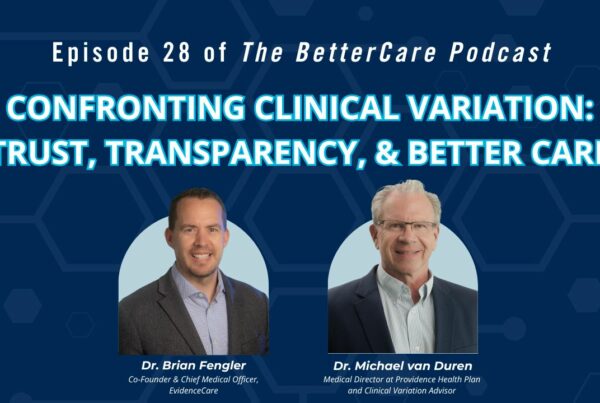EvidenceCare’s Fireside Chat series started during the pandemic to help ease the disconnect everyone in the industry was feeling and to bring healthcare leaders together to learn and connect over industry topics and issues.
We continue to host fireside chats once a quarter to bring a sense of community to the healthcare industry in an intimate virtual gathering focused on creating valuable conversations among leaders from various health systems.
As 2022 has been a difficult year for many hospitals and health systems, our recent event – Mastering Hospital Margins – allowed attendees to discuss common challenges, trends for 2023, and outside resources to combat these challenges. The fireside chat was hosted by EvidenceCare CEO Bo Bartholomew and consisted of a Q&A session with Paul Keckley, Managing Editor of The Keckley Report.
Read and subscribe to The Keckley Report.
Here are some highlights from the fireside chat:
The Unique Challenge of 2022 for Health Systems
2022 has been a difficult year as health systems are still working to recover from two major issues caused by the COVID-19 pandemic – workforce issues and operating margins. These two issues go hand in hand as the workforce is one of health systems’ most significant and fastest-growing expenses. According to the American Hospital Association, hospital expenses have increased by over $135 billion in 2022 compared to 2021. $86 billion of that increase is tied to labor.
“A big issue that compounds operating margins is the fact that we’re still recovering from workforce shortage issues and the traveler’s cost. In fact, 53-68% of hospitals have had a negative operating margin due to the cost of labor.” Paul Keckley
In addition to the increase in labor costs, the economic environment will continue to have an impact on hospital margins. Drugs and supplies are priced at an all-time high due to inflation. Hospitals were already operating on thin margins, and this increase in expenses have taken a toll on hospitals.
Over 33% of hospitals are operating on negative margins, according to the AHA. Running in the negatives is increasingly challenging since the Federal Reserve recently approved a 0.75-point increase in interest rates, making them the highest since 2008. This means that debt for the health systems costs more.
After a series of financial difficulties that have negatively affected many hospitals, financial recovery is not likely in 2023 as workforce challenges are expected to grow. This is causing hospitals to cut costs in any way they can by outsourcing, restructuring, etc.
Are Provider-sponsored Health Plans Sustainable?
With the evolution to value-based care, many health systems now operate a health plan in complete sponsorship with or in collaboration with a major payer. This structure has its advantages, such as better patient care, an integrated experience, and brand loyalty. But most importantly, provider-sponsored health plans have helped many hospitals stay afloat financially during this challenging time.
“This was a smart move in the last half of 2018 through 2021. Having a health plan was the salvation for many health systems because they were getting paid and not spending money on care due to the lack of demand that can be attributed to alternative treatment methods, self-care, etc.” Paul Keckley
Demand is expected to increase, which may spark concern for those relying on health plans to impact operating margins positively. According to Fierce Healthcare, the 2008 recession caused fear of layoffs and job cuts, which drove many people to seek care while insured. This significant increase in utilization and the associated costs caused a substantial decline in payer earnings.
“There’s some fear that some of this pent-up demand will return to those systems that sponsored plans. And they may not see the operating margins on their plan side that they may have projected.” Paul Keckley
How Government Policies & Inflation Affect Health Systems
There is some hope for health systems that have been struggling. And according to Keckley, there is movement in DC that may have the ability to positively impact health systems in 2023.
“The administration is pushing hard to Expand Access to Emergency Care Services in Rural Communities. Hospitals must apply for it, but there’s money set aside so that some rural health providers can migrate from trying to occupy beds to doing other things with their capital.” Paul Keckley
According to CMS, the proposed rule will allow small rural hospitals to provide emergency services, observation care, and additional medical services to their patients. According to the statutory legislation, rural hospitals will be eligible to receive payment for services provided on or after January 1, 2023.
Keckley also said, “There is potential for an impasse in DC, which means any additional funding is not going to be through Medicare reimbursement that we would expect, but the sequester might be a caveat. The funds that would normally be a 4% hit on hospitals could be delayed due to a ‘recession or inflation.’”
Inflation has affected everyone in the healthcare industry this year, and experts don’t expect a solution anytime soon. According to a McKinsey report, the US national health expenditure is expected to be $370 billion higher by 2027 compared with pre-pandemic projections due to inflation.
Health systems need to develop a defense strategy against the continued effects of inflation. Increasing productivity with technology is one way hospitals can continue to meet demand while saving on labor costs. A clear goal and plan of action from executives can also help health systems in these times of uncertainty.
Can Technology Make a Difference for Health Systems?
There are a lot of health systems making investments in technological innovation, both in-house and vendor-supported, but many in the group acknowledged it takes time to see ROI for many of these investments.
According to Keckley, hospital-at-home technology is worth watching as a solution to workforce issues. “This program is different than homecare. It is doing acute and ancillary procedures in the home with telemonitoring and digitization. It’s still in the pilot stage, so the ROI for those investments is unknown.”
A variety of workflow-enhancing technology is available to alleviate many of the challenges hospitals are currently facing. Streamlining the workflow of clinical staff, eliminating unnecessary administrative tasks, improving task efficiency, and preserving staff resources can all be done through technology.
The amount of technology available can be overwhelming. To choose a technology that will be the most beneficial, health systems need to evaluate areas of opportunity and invest accordingly. For technology to have the biggest impact, health systems must train and educate staff, develop a technology portfolio strategy, evaluate how the technology can reduce organizational friction, and assess the alignment of technology with organizational goals.
Margin-Improving Technology
We hope the insights from this fireside chat event were beneficial. If you’d like to learn more about how EvidenceCare can help your health system improve margins, please contact us here.









